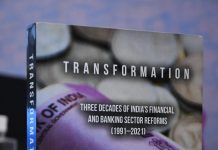Bhaskar Parichha
 After China, India’s mobile consumption is the second largest in the world. There are about 120 crore mobile subscribers right now in India whilst the country’s population is around 130 crores.This is a mammoth revolution taking place in the lives of even the most ordinary people. The telecom business got itself into a high velocity of transformation soon after liberalisation and the growth since the 1990s is mind-boggling. One of the fastest growing mobile bazaars in the world, India’s cell phone use grew more than twenty-five times in less than two decades. There were roughly four crore mobile subscribers in 2001 whereas today almost every Indian has a cellular phone.
After China, India’s mobile consumption is the second largest in the world. There are about 120 crore mobile subscribers right now in India whilst the country’s population is around 130 crores.This is a mammoth revolution taking place in the lives of even the most ordinary people. The telecom business got itself into a high velocity of transformation soon after liberalisation and the growth since the 1990s is mind-boggling. One of the fastest growing mobile bazaars in the world, India’s cell phone use grew more than twenty-five times in less than two decades. There were roughly four crore mobile subscribers in 2001 whereas today almost every Indian has a cellular phone.
Besides number-crunching, the mobile phone has exceptionally supported the socio-economic development of the country. If it has been playing a tremendous role in narrowing down the rural-urban digital divide, the gizmo has helped in transparency and efficiency. With the onset of e-governance in India, officialdom isn’t the same any more. Governments across the board have pragmatically used the mobile telephony to reach out to the rural folks. How all this has come about and what accounts for this transformation?
 Ravi Agrawal’s ‘India Connected: How the Smartphone is Transforming the World’s Largest Democracy’ has all the answers. An exceptional book on the subject and first of its kind, ‘India Connected’ is a factual guide to know all that has been happening in mobile telephony. Managing editor of Foreign Policy magazine, Agrawal sees an equivalence of India’s mobile makeover in early 20th century America, when cars metamorphosed the Americans. If it was the car for Americans, the Smartphone is for the Indians.
Ravi Agrawal’s ‘India Connected: How the Smartphone is Transforming the World’s Largest Democracy’ has all the answers. An exceptional book on the subject and first of its kind, ‘India Connected’ is a factual guide to know all that has been happening in mobile telephony. Managing editor of Foreign Policy magazine, Agrawal sees an equivalence of India’s mobile makeover in early 20th century America, when cars metamorphosed the Americans. If it was the car for Americans, the Smartphone is for the Indians.
Between 2014 and 17, when Agrawal was the chief of CNN’s Delhi bureau, he had the opportunity to gaze at the vast social and political changes that the Smartphone was creating in the country. “I started asking myself ‘could the Smartphone be more than just a device? Could it be an enabler of social change?’ America was transformed by the car, by automobile technology; will the Smartphone do the same for India?”,Agrawal felt.
‘India Connected’ is a cluster of eight essays – neatly divided in three parts – about the people whose lives have been transformed by the technology. The book captures the realism, the magic and the indispensability of this tiny contraption, and the vast changes associated with it – the innovations, the legislations, the souk and the digit.
Whether it is Phoolwati, a woman living in a small village in Rajasthan, who is an ‘Internet saathi’, teaching other rural women how to access the internet as part of a programme run by Google and Tata Trusts; or a village in Gujarat where women were deprived of smart phones because of the deeply patriarchal belief that they would use it to “run away”; or even of a young man who taught himself English using the Hello English app and runs a successful coaching centre, the book is a charming read to say the least. Stories of hundreds of individuals and institutions – who are the building blocks of this volume – are told in unfathomable details.
There are stories about how teachers and school principals in Haryana have been organized into WhatsApp groups for better communication because none of them have email addresses but everyone uses WhatsApp. “WhatsApp has allowed Indians to leapfrog email. While an email address can often be a form of identity in the West, in India one’s identity is often tethered… to a mobile number,” writes Agrawal in the book.
In the West, technological advancement has progressed gradually—from landline phones, to dial-up connections, to broadband access, and now 4G data on phones. But the vast majority of Indians, particularly low- income and rural citizenry, have leapfrogged straight to the Smartphone era, upsetting centuries of tradition and barriers of wealth, language, literacy, caste, gender and even economic status.
What makes ‘India Connected’ unbiased and at the same time comprehensible is that Agrawal interviewed start-up founders, Uber drivers, users of online dating services, privacy and data protection activists, gaming addicts and even actress Sunny Leone.
Agrawal touches upon how the way Indians use mobiles has shaped several Smartphone technologies and new services have evolved—the “lite” versions of apps, or cash-only payments for Ola , or the ability to switch between languages, or the “download content” option for videos on YouTube and Netflix for watching afterwards because of erratic data speeds and low Wi-Fi penetration in Indian homes. The contention of the book is that ‘a new generation of connected Indians has an immense opportunity to act responsibly in shaping the country in which they want to live.’
The ‘Magic Device’ – as Ravi Agrawal calls in the introduction – has an equally absorbing narrative. For those who want to be familiar with the history of the Smartphone revolution ‘India Connected’ is an indispensable read.
India Connected
Ravi Agrawal
Oxford University Press
2/11, Ground Floor, Ansari Road,
Daryaganj, New Delhi – 110002
Rs 550



















